配位化合物综述:结构、稳定性和生物学意义
IF 3.1
3区 化学
Q1 CHEMISTRY, INORGANIC & NUCLEAR
引用次数: 0
摘要
配位化合物是含有一个或多个与配体结合的金属中心的分子。配体可以是原子、离子或分子,可以将电子转移到金属上。这些化合物可以带电,也可以是中性的。带电时,邻近的反离子有助于稳定复合物。金属离子位于络合物离子的中心,周围环绕着称为配体的其他分子或离子。配体可视为通过配位与核心离子共价键合。通过了解化学中的配位理论,可以深入了解络合物的几何形状和配位化合物的结构,配位化合物由一个中心原子或分子与周围的原子或化合物相连组成。无机配位化合物具有不同的性质,可用于合成有机分子。化学物质的配位对生物的生存至关重要。金属配合物也是各种生物过程所必需的,许多被称为金属酶的酶都是由金属配合物组成的。这些金属络合物是天然存在的。本文章由计算机程序翻译,如有差异,请以英文原文为准。
A review of coordination compounds: structure, stability, and biological significance
Coordination compounds are molecules that contain one or more metal centers bound to ligands. Ligands can be atoms, ions, or molecules that transfer electrons to the metal. These compounds can be charged or neutral. When charged, neighboring counter-ions help stabilize the complex. The metal ion is located at the center of a complex ion, surrounded by other molecules or ions known as ligands. Ligands can be thought of as covalently bonded to the core ion through coordination. Understanding coordination theory in chemistry provides insight into the geometric shape of complexes and the structure of coordination compounds, which consist of a central atom or molecule connected to surrounding atoms or compounds. Inorganic coordination compounds exhibit different properties and are used in synthesizing organic molecules. The coordination of chemicals is vital for the survival of living organisms. Metal complexes are also essential for various biological processes, with many enzymes, known as metalloenzymes, being composed of metal complexes. These metal complexes occur naturally.
求助全文
通过发布文献求助,成功后即可免费获取论文全文。
去求助
来源期刊

Reviews in Inorganic Chemistry
化学-分析化学
CiteScore
7.30
自引率
4.90%
发文量
20
审稿时长
1 months
期刊介绍:
Reviews in Inorganic Chemistry (REVIC) is a quarterly, peer-reviewed journal that focuses on developments in inorganic chemistry. Technical reviews offer detailed synthesis protocols, reviews of methodology and descriptions of apparatus. Topics are treated from a synthetic, theoretical, or analytical perspective. The editors and the publisher are committed to high quality standards and rapid handling of the review and publication process. The journal publishes all aspects of solid-state, molecular and surface chemistry. Topics may be treated from a synthetic, theoretical, or analytical perspective. The editors and the publisher are commited to high quality standards and rapid handling of the review and publication process.
Topics:
-Main group chemistry-
Transition metal chemistry-
Coordination chemistry-
Organometallic chemistry-
Catalysis-
Bioinorganic chemistry-
Supramolecular chemistry-
Ionic liquids
 求助内容:
求助内容: 应助结果提醒方式:
应助结果提醒方式:


